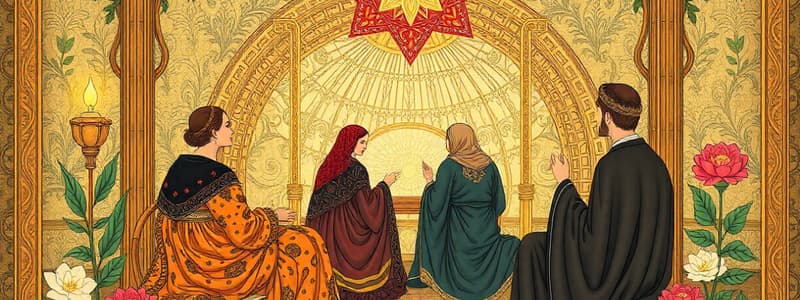Podcast
Questions and Answers
What two groups made up the Jewish population in the 18th century, showing a variety of beliefs and practices?
What two groups made up the Jewish population in the 18th century, showing a variety of beliefs and practices?
Hasidic and Non-Hasidic Jews
In the early 18th century, Jews were encouraged to leave the Jewish community and convert to Christianity.
In the early 18th century, Jews were encouraged to leave the Jewish community and convert to Christianity.
False (B)
What significant change did the Reform Judaism movement make to the traditional practice of Jewish prayer?
What significant change did the Reform Judaism movement make to the traditional practice of Jewish prayer?
The language of prayer changed from Hebrew to English.
Reform Jews believe that mitzvot are only meaningful if they contribute to a person's relationship with God.
Reform Jews believe that mitzvot are only meaningful if they contribute to a person's relationship with God.
What did Samson Raphael Hirsh assert as the only acceptable Jewish belief in response to the changes introduced by Reform Judaism?
What did Samson Raphael Hirsh assert as the only acceptable Jewish belief in response to the changes introduced by Reform Judaism?
Orthodox Judaism emerged as a direct response to the rise and influence of the Reform movement.
Orthodox Judaism emerged as a direct response to the rise and influence of the Reform movement.
According to Conservative Judaism, how has Jewish law and tradition always been open to change?
According to Conservative Judaism, how has Jewish law and tradition always been open to change?
Conservative Jews tend to treat the observances of Shabbat and Kashrut more strictly than Orthodox Jews.
Conservative Jews tend to treat the observances of Shabbat and Kashrut more strictly than Orthodox Jews.
What is the central principle of Reconstructionist Judaism?
What is the central principle of Reconstructionist Judaism?
Reconstructionist Judaism believes that an individual mitzvah can be modified or rejected if the community no longer finds it meaningful.
Reconstructionist Judaism believes that an individual mitzvah can be modified or rejected if the community no longer finds it meaningful.
Flashcards
Pre-Enlightenment Judaism
Pre-Enlightenment Judaism
Jewish practice before the 19th-century Enlightenment.
Reform Judaism
Reform Judaism
Jewish movement emphasizing adaptability to modern life.
Orthodox Judaism
Orthodox Judaism
Jewish movement emphasizing strict adherence to traditional practices.
Conservative Judaism
Conservative Judaism
Signup and view all the flashcards
Reconstructionist Judaism
Reconstructionist Judaism
Signup and view all the flashcards
Mitzvot
Mitzvot
Signup and view all the flashcards
Shabbat
Shabbat
Signup and view all the flashcards
Kashrut
Kashrut
Signup and view all the flashcards
Enlightenment
Enlightenment
Signup and view all the flashcards
Hebrew
Hebrew
Signup and view all the flashcards
English
English
Signup and view all the flashcards
Hasidic
Hasidic
Signup and view all the flashcards
Ashkenazi
Ashkenazi
Signup and view all the flashcards
Sephardi
Sephardi
Signup and view all the flashcards
Rabbi Samson Raphael Hirsch
Rabbi Samson Raphael Hirsch
Signup and view all the flashcards
Genesis
Genesis
Signup and view all the flashcards
Study Notes
Branches of Judaism
- Pre-Enlightenment Judaism: No formal movements existed in the early 18th century. Jewish beliefs and practices varied, but Jews couldn't easily integrate into the Christian world, so no strict definition of "proper Jew" was needed.
Reform Judaism
- Post-Enlightenment (19th century): Reform Judaism emerged to make Judaism compatible with a changing world. Elements changed, for example, prayer was in English instead of Hebrew. Reform Jews saw the mitzvot as meaningful if enhancing their relationship with God. Traditional restrictions on Shabbat and Kashrut were often not observed.
Orthodox Judaism
- Response to Reform: Orthodox Judaism emerged in response to Reform Judaism. Orthodox Jews emphasized the Torah's literal interpretation, arguing every detail was given by God on Mount Sinai, with a commentary. Traditional practices were viewed as expressions of God’s will and couldn't be changed.
Conservative Judaism
- Moderate Approach: Conservative Judaism tried to find a middle ground. They acknowledged the possibility of changing Jewish law and traditions, but maintained the core system of mitzvot couldn't be altered. They allow for modifications like giving women more roles in synagogue rituals and more flexibility with prayers to reflect modern life.
Reconstructionist Judaism
- 20th-Century Movement: Reconstructionism is the most recent movement, emphasizing "The tradition has a vote, not a veto." The entire system of mitzvot is important, but individuals can reject or modify mitzvot if the community no longer finds them meaningful.
Studying That Suits You
Use AI to generate personalized quizzes and flashcards to suit your learning preferences.




